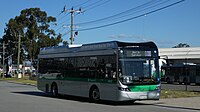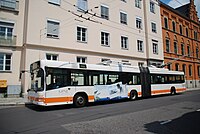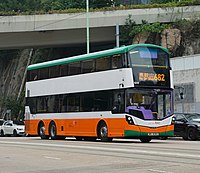Difference between revisions of "Bus transport in Hafnir"
Jump to navigation
Jump to search
LeotropolisG (talk | contribs) |
LeotropolisG (talk | contribs) |
||
| Line 23: | Line 23: | ||
|map_state = collapsed | |map_state = collapsed | ||
}} | }} | ||
| − | Bus transport is the oldest public transport service in Hafnir, the capital city of Reykanes, having been introduced in 1899. Since 1950, services have been operated by the city government. The current fleet consists of 130 buses and consists of 11 lines plus 5 night lines, which cover the entire city. | + | Bus transport is the oldest public transport service in Hafnir, the capital city of Reykanes, having been introduced in 1899. Since 1950, services have been operated by the city government. The current fleet consists of 130 buses and consists of 11 lines plus 5 night lines, which cover the entire city. 40% of energy used for the electric buses is renewable energy. |
==History== | ==History== | ||
Bus transport in Hafnir started in 1899 under the colonial period by the company called strætisvagn" (urban bus, literally "street carriage"), which become defunct in 1950 and the bus services came under control by the local government. | Bus transport in Hafnir started in 1899 under the colonial period by the company called strætisvagn" (urban bus, literally "street carriage"), which become defunct in 1950 and the bus services came under control by the local government. | ||
Revision as of 13:14, 13 March 2023
| Bus transport in Hafnir | |
|---|---|
 Chienrú K8D double decker bus in Hafnir | |
| Overview | |
| Locale | Hafnir, Reykanes |
| Transit type | Public bus transport |
| Number of lines | 11 (+5 night lines) |
| Operation | |
| Began operation | 1899 |
| Operator(s) | Government of Hafnir |
| Number of vehicles | 130 |
| Technical | |
| System length | 1,662 km (1,033 mi) |
Bus transport is the oldest public transport service in Hafnir, the capital city of Reykanes, having been introduced in 1899. Since 1950, services have been operated by the city government. The current fleet consists of 130 buses and consists of 11 lines plus 5 night lines, which cover the entire city. 40% of energy used for the electric buses is renewable energy.
History
Bus transport in Hafnir started in 1899 under the colonial period by the company called strætisvagn" (urban bus, literally "street carriage"), which become defunct in 1950 and the bus services came under control by the local government.
Routes
| Line no. | Route colour | Route | Running Interval (weekdays) |
Days of service |
|---|---|---|---|---|
| 1 | Red | Laugardalur – Hafnarfjörður | 10/15 min | Mo to Su |
| 2 | green-silver | Laugardalur – Salahverfi | 15/30 min | Mo to Su |
| 3 | yellow | Laugardalur – Kringlan | 15/30 min | Mo to Su |
| 4 | blue | Laugardalur – Divanborg | 15/30 min | Mo to Su |
| 5 | brown | Nauthóll – Norðlingaholt | 15/30 min | Mo to Su |
| 6 | green-orange | Laugardalur – Grafarvogur | 10/15 min | Mo to Su |
| 7 | white | Mjódd – Laugardalur | 15/30 min | Mo to Su |
| 8 | purple | Skerjafjörður – Ártún | 15/30 min | Mo to Su |
| 9 | pink | Sléttuvegur – Laugardalur | 15/30 min | Mo to Su |
| 10 | light blue | Grandi – Laugardalur | 15/30 min | Mo to Su |
| 11 | dark Green | Vesturbær – Laugardalur | 15/30 min | Mo to Su |
| Line no. | Route colour | Route | Running Interval (weekdays) |
Days of service |
|---|---|---|---|---|
| 1 | Red | Laugardalur – Hafnarfjörður | 10/15 min | Mo to Su |
| 2 | green-silver | Laugardalur – Salahverfi | 15/30 min | Mo to Su |
| 3 | yellow | Laugardalur – Kringlan | 15/30 min | Mo to Su |
| 4 | blue | Laugardalur – Divanborg | 15/30 min | Mo to Su |
| 5 | brown | Nauthóll – Norðlingaholt | 15/30 min | Mo to Su |
Fleet
Single-decker
| Quantity | Manufacturer | Type | Passengers | Length | Notes | Photo |
|---|---|---|---|---|---|---|
| 30 | Chienrú | Chienrú KLD | 60–70 | 9–13 | 
| |
| 30 | Chienrú | Chienrú 7700 Trolley bus version | 60–70 | 12 m | 
| |
| 50 | Chienrú | Chienrú K8HDR | 60–90 | 12 m | 
|
Double-decker bus
| Quantity | Manufacturer | Type | Passengers | Length | Notes | Photo |
|---|---|---|---|---|---|---|
| 20 | Chienrú | Chienrú K8D | 110 | 13.7 m | 
|
